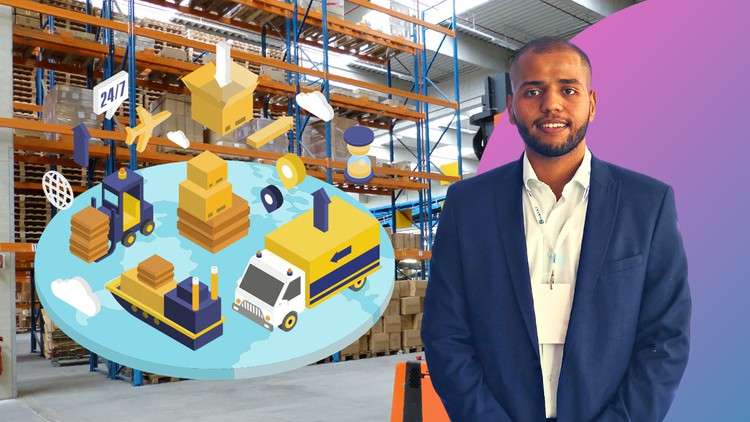
Learn the skills to be a Supply Chain professional by aligning goals, improving efficiencies and increasing returns
What you will learn
Gain an understanding of Meeting Customer Expectations.
Gain an understanding of Supply Chain Sustainability.
Learn how to manage Inventory.
Understand the Economic Order Quantity (EOQ).
Learn about Inventoy Carrying Costs and Ordering Costs and their relationship.
Learn about a Stock-Out.
Learn about Customer Service and Safety Stock.
Gain an understanding of Production Activity Control.
Learn to calculate Rated Capacity.
Learn to calculate Available Capacity, Available Time, Utilization and Efficiency.
Learn Capacity Requirements Planning (CRP) to check the capacity needed for the Material Requirements Plan (MRP).
Learn how MRP software works – understand Planning Orders, Released Orders, MRP Action Messages and MRP Exception Messages.
Gain an understanding of Demand and the types of demand.
Learn to spot the different patterns of demand.
Learn to forecast demand using various forecasting techniques, which is the easiest method, which method will give you the best results.
Understand forecast error and how to deal with it.
Gain an understanding of Manufacturing.
Learn the different manufacturing strategies and what environment is suitable for your product.
Learn about the Product Life Cycle and how it influences the manufacturing strategy.
Learn about the various manufacturing processes and layouts in relation to the product.
Description
“From Procurement to Delivery: A Complete Guide to Supply Chain Management” is a comprehensive online course designed for individuals who are interested in gaining a deeper understanding of supply chain management.
The course is divided into several modules, each covering a different aspect of the supply chain management process, from procurement to delivery. The course starts with an introduction to supply chain management and its importance in today’s business landscape.
The course then delves into the various elements of the supply chain, including supplier selection, sourcing, procurement, transportation, warehousing, and inventory management. It provides learners with a clear understanding of the critical role that each of these elements plays in the overall supply chain process.
The course also covers supply chain optimization techniques and strategies, such as lean manufacturing and just-in-time inventory management. Learners will explore how these strategies can help organizations to reduce waste, increase efficiency, and enhance customer satisfaction.
Throughout the course, learners will be exposed to real-world case studies and examples to illustrate the concepts and principles of supply chain management. They will learn how to apply these concepts and strategies in their own organizations to optimize their supply chain processes.
The course concludes with a discussion of emerging trends and technologies in supply chain management, such as blockchain and artificial intelligence. Learners will gain insights into how these technologies are transforming the supply chain landscape and how they can be leveraged to improve supply chain efficiency and effectiveness.
By the end of the course, learners will have a deep understanding of the entire supply chain management process, from procurement to delivery. They will have gained the knowledge and skills necessary to optimize their organization’s supply chain processes and enhance its overall competitiveness in the marketplace.
“From Procurement to Delivery: A Complete Guide to Supply Chain Management” is a comprehensive online course that offers a detailed overview of the entire supply chain management process.
The course is structured into several modules that cover different aspects of the supply chain process, including procurement, transportation, warehousing, and delivery. Each module delves deep into the subject matter, providing learners with a complete understanding of the concepts and best practices associated with each stage of the supply chain process.
The course starts with an introduction to supply chain management and its importance in today’s business landscape. It then moves on to explore the different elements of the supply chain process, beginning with supplier selection and sourcing. The course covers the procurement process in detail, including the best practices for managing supplier relationships, negotiating contracts, and ensuring supplier performance.
The course then explores the transportation and logistics aspects of the supply chain process, including the different modes of transportation, the role of freight forwarding, and the importance of effective route planning. Learners will also explore the critical role that warehousing plays in the supply chain process, including inventory management and storage solutions.
Finally, the course examines the delivery stage of the supply chain process, including last-mile delivery and customer service. The course concludes with an overview of emerging trends and technologies in supply chain management, such as blockchain and artificial intelligence.
Throughout the course, learners will have access to real-world case studies and examples, providing them with practical insights into how to optimize the supply chain process. By the end of the course, learners will have a complete understanding of the entire supply chain process from procurement to delivery, making them well-equipped to optimize their organization’s supply chain operations and enhance its competitiveness in the marketplace.
Benefits:
1. Comprehensive overview: The course provides a comprehensive overview of the entire supply chain process, from procurement to delivery, ensuring that learners have a complete understanding of all the key elements of supply chain management.
2. Real-world case studies: The course includes real-world case studies and examples, providing learners with practical insights into how to optimize their organization’s supply chain operations.
3. Improved efficiency: By learning the best practices for each stage of the supply chain process, learners will be able to identify areas for improvement and implement strategies to enhance supply chain efficiency.
4. Enhanced competitiveness: With a complete understanding of the supply chain process, learners will be equipped to optimize their organization’s supply chain operations and improve its overall competitiveness in the marketplace.
5. Emerging trends and technologies: The course covers emerging trends and technologies in supply chain management, such as blockchain and artificial intelligence, ensuring that learners are up-to-date with the latest advancements in the field.
Content